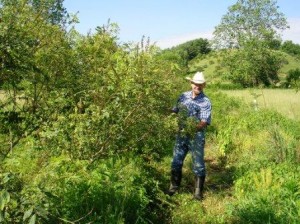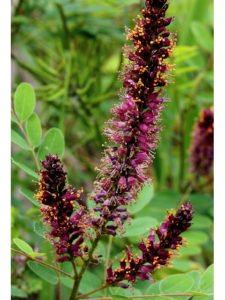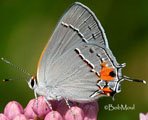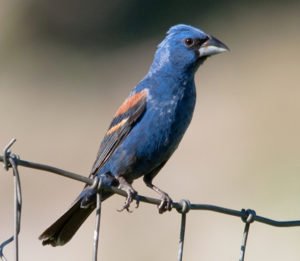False Indigo Bush, Amorpha fruticosa
This native, leguminous shrub is one of the best riparian plants for creating wildlife habitat and improving water quality. It is fast growing and deer don’t like to eat it, so if you want success in your shrub or wildlife plantings this is a winner. We planted two year old seedlings from the Virginia Department of Forestry along one of the intermittent streams on the farm three years ago and they are now over six feet tall.
This shrub has spectacular spiked blossoms which produce a tremendous seed load; the blossoms attract pollinators and the seeds are very much needed by birds such as sparrows and quail.
Northern Bobwhite populations have plummeted here in the Valley of Virginia. What they need is “shrubby” habitat so we’ve been planting shrub thickets for years. We select shrubs that will provide both shelter and food for Quail and other birds. Along with False Indigo Bush we have planted Bicolor Lespedeza, American Plum, Washington Hawthorn, Red Osier Dogwood and others; False Indigo Bush is the most successful shrub we have planted.
Because of the fragrant and colorful blossoms pollinators are attracted to False Indigo Bush. According to the Lady Bird Johnson Wildflower Center it is a larval host and nectar source for butterflies and moths including the Grey Hairstreak, Southern Dogface, California Dogface, Hoary Edge, and the Silver Spotted Skipper.
There aren’t many Blue Grosbeaks in the Shenandoah Valley but I have seen them in our False Indigo Bush thickets.
Creat Shrub Thickets
Here in the Valley of Virginia we need more shrub thicket habitat and False Indigo Bush is our “go to” shrub for making thickets in just a few years. Plant seedlings five feet apart in clusters that are at least thirty feet wide or put False Indigo Bush seeds in with a native prairie planting of native grasses and other forbs such as Partridge Pea and Purple Coneflower.
For more information and possible funding contact me or check out these resources:
Natural Resources Conservation Service
Your local Soil and Water Conservation District





17 Comments
Leave your reply.